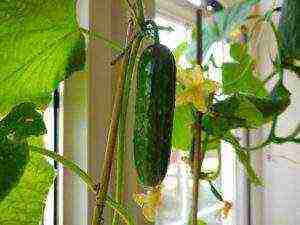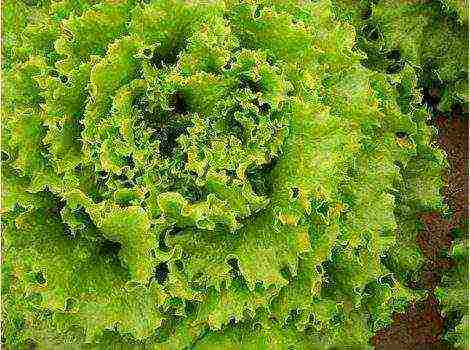Content [show]
 Lizonka F1 is a domestic hybrid of large-fruited remontant garden strawberries with excellent characteristics. This variety is famous for the optimal ratio of yield and unpretentiousness, due to which it is very much in demand among gardeners.
Lizonka F1 is a domestic hybrid of large-fruited remontant garden strawberries with excellent characteristics. This variety is famous for the optimal ratio of yield and unpretentiousness, due to which it is very much in demand among gardeners.
Description of the variety
Garden strawberry "Lizonka F1" refers to ultra-early ripening, high-yielding and large-fruited hybrid forms. It ripens a couple of weeks earlier than other early varieties, and also has the longest and most productive fruiting period.
The flowering of the variety is abundant, the flowers are bright pink, with the scent of garden violets. The flower stalks are very evenly distributed throughout the strawberry bush. Often "Lizonka F1" is used as a balcony or ampelous culture.
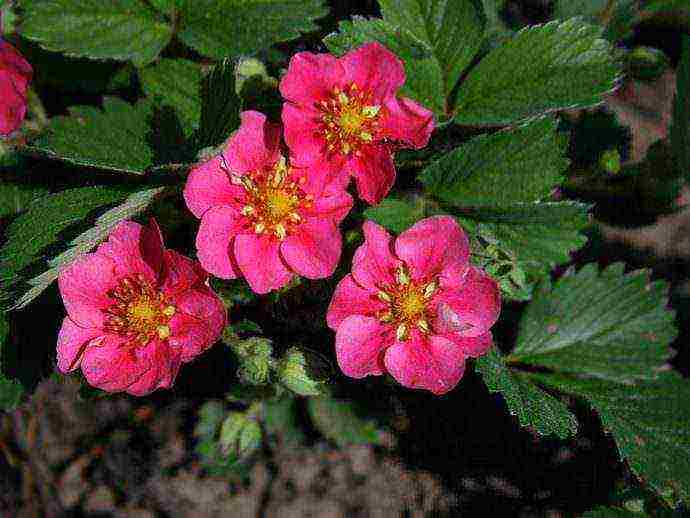
Characteristics of berries
The variety forms very attractive dark red berries - dense, with a magnificent delicate and sweet taste, as well as a pronounced berry aroma. The average weight of one berry is 30-40 g.
Also read: Irga: features of cultivation and use
Harvesting strawberries: varieties, planting dates (video)
Growing technology from seeds
Growing strawberries from seeds is currently gaining in popularity. At home, it is very convenient to sow garden strawberry seeds in peat tablets. However, the following highly effective technique is most commonly used:
- the seed is laid out on a damp cloth and covered with a plastic bag, and then placed in the warmest place; with sufficient moisture, the seeds hatch after about a week;
- when the sprouts reach a sufficient height, they are planted in the ground. The soil mixture for planting should be loose and fertile, and also undergo pre-sowing disinfection with a high-temperature regime or a solution of potassium permanganate;
- the sprouts are very carefully planted in the prepared soil at a standard distance of 2-3 cm from each other.It is very convenient to use indoor mini-greenhouses for growing seedlings, which make it easy to maintain optimal microclimatic conditions;
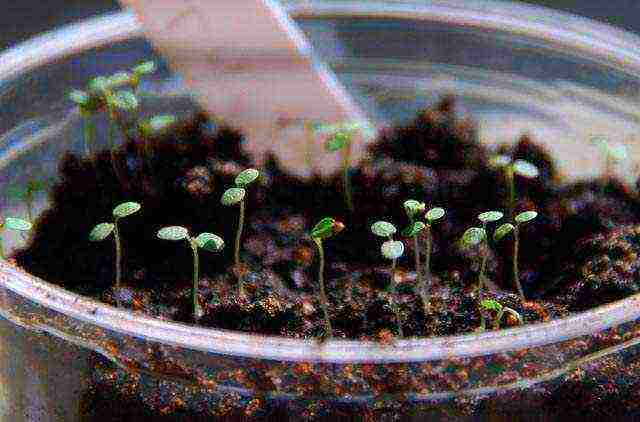
- after a couple of months, the plants are carefully picked into individual planting containers.
- in the spring, a gradual hardening of strawberry seedlings is carried out: on warm days, plants are taken outside, gradually increasing their time in the fresh air;
- after warm weather sets in and the threat of late spring frosts has passed, strawberry seedlings are planted in a permanent place in open ground. In the early days, it is advisable to shade the plants to protect them from sunburn and help them quickly adapt and take root well.
We recommend reading about other remontant strawberry varieties on the page src = "https://flwn.imadeself.com/1/wp-content/uploads/2018/04/zemlya-klubnika-krupnoplodnaya-f1-lizon-ka-kak-vyraschivat- 30.jpg »alt =" land strawberry large-fruited f1 lizonka how to grow "width =" 690 "/>
Rules for caring for large strawberries
Care for strawberries "Lizonka F1" should be started in spring even before the surface of the soil is completely free of snow. Covering strawberry plantings in arcs with garden film or non-woven material, you can bring the harvest time of early berries closer by about a week. Large-fruited garden strawberries need careful care, which consists of the following procedures:
- removing any plants that shade strawberries, since this variety is picky about lighting;
- carrying out frequent and abundant watering during the growing season;
- fertilization 2-3 times for the entire growing season, better than organic. Often, high-quality humus or compost is used for this, with which strawberry beds are mulched;
- top dressing not only with nitrogen, but also with potassium, since large-fruited strawberries are extremely demanding on soil fertility;
- spraying strawberries with such effective and modern means as Fundazol, Gaupsin, Metaxil and Quadris - to protect against diseases and pests.
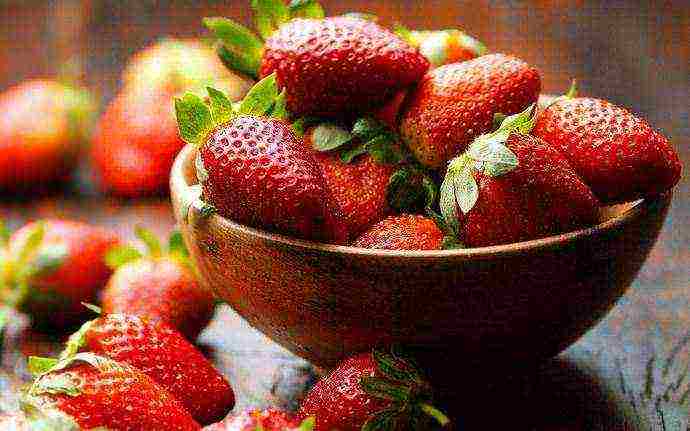
Care for remontant large-fruited strawberries in the autumn period is carried out in the same way as for small-fruited ones.
Variety reviews
Absolutely all varieties of remontant garden strawberries require high-quality agricultural technology and regular watering and fertilizing with appropriate fertilizers, and Lizonka F1 is no exception. According to gardeners, this variety blooms with beautiful pink flowers, and bears fruit until the very frost. Strawberry bushes look very impressive not only on garden beds, but also on flower beds or flower beds. Large and fragrant berries "Lizonki F1" ripen very early.
How to plant strawberries with seeds (video)
Experienced gardeners recommend in March, right in the snow, to feed the plants with nitrogen fertilizers in order to get the most bountiful harvest. In addition, in central Russia, the variety tolerates winter well, practically without losses, which makes it even more popular.
Attention, only TODAY!
Reviews and comments
Did you find a mistake in the text? Please select it and press Ctrl + Enter. Thank you!
Rating:
(
estimates, average:
out of 5)
The seeds of large-fruited hybrids are expensive. The package usually contains only 3 to 10 small seeds. It is easy to lose them in seed boxes and bowls, so it is better to sow the seeds of such strawberries in peat tablets. The method is also convenient in that you do not need to sift and steam the soil mixture, and then dive the seedlings.
Sow or not?
Do not think that growing strawberries from seeds is not reliable and laborious. It's useful and fun! Firstly, in one season, you can get a lot of bushes of a new variety. Secondly, strawberry seedlings grown from seeds are healthier than propagated by a mustache and bush division.
Many special, multiplied seeds, varieties and hybrids are now on the market and are growing in popularity.
Seed-propagated varieties and hybrids
Enchantress, "Search"
Decorative due to huge rich pink flowers and large, surprisingly fragrant berries.
Repaired highly productive variety.
With proper care, it blooms and bears fruit throughout the summer.
Bright red elongated berries are distinguished by a special aroma, extraordinary sweetness and juiciness. Ideal for balcony cultivation in containers and hanging baskets.
Pink Dream, "Search"
The abundance of pink clove-shaped flowers and sweet berries is a real decoration of the garden, balcony, veranda! Repaired early ripening variety. Usov practically does not give.
A compact bush with bright green leaves bears fruit from early summer. Very sweet and juicy medium-sized berries. Ideal for balcony cultivation in containers and hanging baskets.
F1 C-141, "Russian Garden"
Stunning remontant strawberry with incredibly rich pink flowers. It blooms continuously throughout the season, which provides the plant with a constant decorative effect.
Forms a large number of mustaches, strewn with flowers and fragrant, elongated berries at the same time!
F1 Russian size, "Russian Garden"
Individual berries of this hybrid can reach incredible sizes: up to 50 g each!
Very tasty, with juicy pulp, they begin to ripen two weeks earlier than other varieties. Abundant fruiting continues until the first frost.
F1 Irishka, "SeDec"
Early ripe remontant hybrid. The plant is compact, 25-30 cm high, mustacheless, give a large number of peduncles. Fruiting before frost. The berries are dark red, weighing 18-25 g, very aromatic. 1.5-2 kg of berries are obtained from one plant. The hybrid is unpretentious to growing conditions, has a high winter hardiness, withstands frosts down to -30 degrees. frost, tolerates both heat and excessive waterlogging. Resistant to major diseases. Recommended for growing in personal plots, as well as at home.
F1 Lizonka, "SeDec"
Ultra-ripe, high-yielding, large-fruited hybrid, ripens two weeks earlier than early varieties, has the longest fruiting period. The flowers are bright, pink. The berries are dark red, dense, with a magnificent delicate and sweet taste and aroma, weighing 30-40 g. From one bush, you can collect up to 2.5 kg of berries per season. The value of the hybrid: high resistance to wetting and gray mold damage. Bears abundantly even in rainy summers.
Sowing dates of strawberries for seedlings
At home, strawberries are sown for seedlings in late February and early March. At an earlier date, strawberries are sown in nurseries in order to put ready-made seedlings for sale at the beginning of the season. If there is no such goal, you should not rush.
Seed preparation for sowing
Place the strawberry seeds between two cotton pads or two to three layers of clean cloth. Place them in another dish, moisten, close with a lid, having previously made several holes in it for ventilation. If you have multiple varieties, label them. Keep them for 2-3 days at a temperature of + 15 ... + 18 degrees, then remove the soaked strawberry seeds in the refrigerator.
After 2 weeks, place the container in a warm (+ 18 ... + 20 degrees) bright place. Check the seeds every 2-3 days so you don't miss the moment of germination (1).
When the strawberry seeds hatch, it is time for sowing. Put peat tablets in a container, fill them with water. Add water until it stops being absorbed by the tablets. Drain the excess.
Place the "naklyevys" in the indentations in the tablets. It is very convenient to do this with a toothpick. You do not need to cover the seeds with earth: strawberries grow better in the light. Seeds are sprinkled only when sowing in the summer in the garden, so that they do not die from overdrying (2).
It is important that the seeds that have hatched do not dry out. To do this, cover the container with a transparent lid or place it in a greenhouse. Place the strawberry crops in a bright place with a temperature not higher than +20 degrees.
Remove condensation from the lid daily, ventilate to prevent mold.If you nevertheless notice the first signs of mold, carefully remove it with a toothpick and drip it with a solution of Maxim or another fungicide (3).
After the first true leaves appear, the shelter can be removed. Sprinkle strawberry roots (if they are bare) to the root collar with a little earth. If you notice that the peat "pillars" are settling, add water to the container until it is completely absorbed, and drain the excess.
How to feed seedlings
Combine adding water every 2 weeks with top dressing. It is better to feed strawberry seedlings with humates or a solution of mineral fertilizers for seedlings. (GUMATEM) (4).
From late April - early March, you can start hardening on the balcony or glazed veranda. At first, cover the seedlings from direct sunlight and wind. Short-term night temperature drop to + 3 ... + 5 degrees. even useful.
Planting strawberries in the ground
You can plant seedlings in the ground when the threat of frost has passed. In well-developed seedlings, the roots are visible on the surface of the peat tablet.
The soil should be loose, fertile, it is advisable to add humus or well-rotted compost. If it is cultivated garden land, 0.5 buckets of sand are enough. The rate of application of complete mineral fertilizers is 30-40g per 1 sq. M. Dig carefully onto the bayonet of the shovel and level so that there is no slope.
To make the rows even, pull the cord on the bed. Mark the row with a groove (5).
Make holes 30 cm apart.Place peat tablets with seedlings (6)
.
Carefully fill the holes with soil so that the strawberry growth point (heart) is at the surface level. Seal (7).
Carefully water the seedlings so as not to blur the soil around the bush (8).
Read on:
Strawberries - the queen of berries
Strawberry is good on any table: a romantic dinner, a children's matinee, an anniversary celebration, a buffet table. Both old and young love her, but there is a reason. Strawberries are not only a very beautiful and tasty berry, but they can also work wonders. Not a berry, but some kind of miracle pharmacy: it contains a huge amount of vitamins and trace elements, stimulates digestion, helps with hypertension and atherosclerosis, heals wounds, pacifies stomatitis and periodontal disease ... Only allergy sufferers should not abuse strawberries, and they themselves know about it ...
Usually, large-fruited strawberries are planted with rosettes, using the mustache of mother plants for this, but there are varieties that can be propagated by seeds. It is very convenient. After all, sockets are difficult to transport over long distances, and for this reason it is difficult for a gardener living far from a big city to acquire good seedlings. Large-fruited strawberries (popularly called strawberries or victoria) of special selection from SeDeK, Sasha F1, Lizonka F1 and Irishka F perfectly reproduces by seeds, without losing the grade. But we must remember that they are hybrids and, when self-collecting seeds with subsequent planting, split into parental and grandparent forms.
Agrofirm "SeDeK" offers unique hybrids of large-fruited remontant strawberries from seeds - Sasha F1, Lizonka F1 and Irishka F... The taste is amazing, the bright red fruits just melt in your mouth!
- Sasha F - a powerful bush up to 30cm high. Gives a full-fledged mustache with rosettes, which very quickly pour a lot of large (diameter 3.5 cm) sweet berries. With good and proper care (watering, feeding), the outlets take root quickly. During flowering, the plant is literally covered with large snow-white flowers. Already in the first year, it yields a harvest of weighty juicy berries weighing up to 35g. The yield per season reaches up to 2 kg per bush. The berries are so sweet that you don't need to add sugar when juicing. Fruiting throughout the summer until the very frost. (Sasha F1 - NEW! 15 families - 29 rubles)
- Lizonka F - an ornamental bush.Against the background of emerald leaves, pearl and dark pink flowers with a thick violet scent flicker. Peduncles are evenly distributed throughout the bush. The first berries appear two weeks earlier than those of Sasha F... In four months, you can collect up to 1 kg 800 g of dense transportable berries! Lizonka Fcan be grown in pots on the balcony as an ampelous culture. (Lizonka F1 - NEW! 15 families - 33 rubles)
- Irishka F - an unpretentious hybrid, perfectly tolerates drought, frost and heavy rains. Gives some whiskers and is considered the best outdoor variety. The berries, although smaller than those of Lizonki F and Sasha Fbut very juicy. Above the compact bush, a powerful peduncle rises by 10 cm, as if strewn with butterflies with large white flowers. These strawberries are perfect for fresh consumption and for making aromatic juices. (Irishka F1 - NEW! 15 families - 33 rubles)
Lizonka F1, Sasha F1 and Irishka F rest only two weeks after a large collection. Bears fruit continuously from early spring to autumn frosts. In the second year, each bush will give you up to 2-3 kg of berries.
Besides, "SeDeK" offers the best varieties of small-fruited strawberries:
- Snow White - with the smell and taste of pineapple;
- Rhine Waltz - with the smell of strawberries and almonds;
- Baron Solemacher - with a delicate strawberry aroma;
- Ali Baba - with the taste of real wild strawberries, etc.
Magnificent berries are very aromatic and tasty, they are just great for making jam and compotes.
Grow strawberries from "SeDeK", eat all year round and be healthy!
The technology of growing remontant strawberries from seeds in the conditions of Central Russia.
Sowing seeds is carried out in early spring (February - March) in seedling boxes. Prepare a soil mixture from the ratio: humus 3 parts + peat 1 part, sod land - 2 parts (sifting it so that there are no lumps), fill the boxes with soil mixture 10 - 12 cm in height and watered well with a weak solution of potassium permanganate. Then grooves are made with a ruler (at a distance of 3 - 4 cm), a depth of 3 - 5 cm on the surface of the soil mixture and strawberry seeds are sown at a distance of 1.5 - 2 cm. After sowing, the seeds are slightly pressed into the soil, but do not fall asleep. The boxes are covered with foil or glass and placed in a warm room (temperature not less than 22 - 24 ° C).
When shoots appear (60 - 80%), the glass or film is removed. Watering is carried out very carefully, so as not to wash off the seeds, with a fine-sprayed sprayer or syringe.
Seedlings are cut into cups or cubes when the 2nd or 3rd true leaf appears.
Seedling care consists in timely watering, loosening, feeding. Planting scheme on plots of 70x30 cm. When grown in seedlings, strawberries give a good harvest in the first year.
Little tricks…
Strawberries aren't actually whimsical - provided you treat them with respect. So that the berry does not hurt and is always green, treat it with horse sorrel, and the more the better. Fill with water, let it brew for a week or even two. Then spray the foliage with infusion and water the bushes. Honestly, following these tips, you will forget about all the diseases of strawberries.
And also, to increase the yield, tear off all the whiskers from the plants.
To reproduce the berries, sprinkle the mustache with earth and do not touch until spring. Transplant it until mid-July, but not in the fall.
Try it and see! Have a nice harvest!
Growing strawberries from seeds is not easy, but exciting. It is important to follow a few rules to get a flowering and fruiting bush.
Growing strawberries from seeds
For a long time, strawberries migrated from orchards and vegetable gardens to window sills and loggias in ordinary apartments. Most often, remontant garden strawberries (often called strawberries) are grown at home.You can choose plants for almost any taste and color, and seedlings are obtained by growing from seeds.
Seeds from trusted agricultural firms can be bought in stores. Another option is to collect seeds from the fruits of your garden beds, however, after free pollination between several varieties, you will get a hybrid plant with special qualities.

Strawberries are often planted in planters or hanging pots.
Seed collection
You can collect strawberry seeds only from varietal bushes, not from hybrids. Otherwise, your young plants will not retain their maternal qualities.
- The berry is chosen ripe, from a fruitful bush, completely corresponding to the variety.
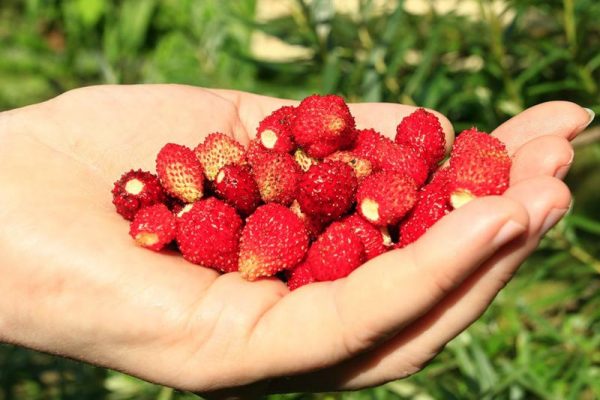
The berry for collecting seeds is chosen ripe, corresponding to the variety.
- With a sharp knife, remove the top layer of the skin with seeds, lay out on a plate to dry.
- It is better to put the plate in a well-ventilated and sunny place so that the pulp of the berry dries quickly and does not rot.
- After a few days, you can harvest the seeds and leave the pulp on a plate.

Dried seeds are scraped off a plate
Video: how to collect strawberry seeds
Preparing the soil for seedlings
Most often, strawberry seedlings are grown at home, much less often - right in the garden. Seedlings appear small and tender, in the open field they can die.
For strawberry seedlings, the easiest way is to use ready-made universal soil from the store. Usually there is no pathogenic microflora in it, and the composition of the soil is quite suitable for growing strawberries.
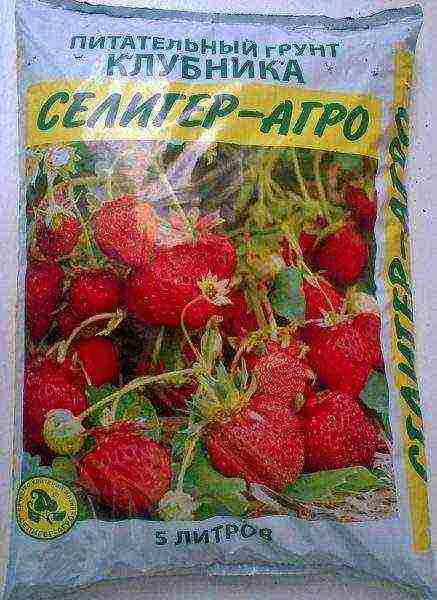
There are special soil mixtures for strawberries on sale, but you can use universal peat-based soils.
The proportions of the components for self-preparation of the soil:
- 1/2 part of sod land;
- 1/4 part of peat;
- 1/4 of the sand.
It is useful to add a little wood ash and vermicompost to this mixture. The soil must be steamed in an oven or steam bath for about 30 minutes to kill weed seeds, eggs, or insect larvae. Sterile soil must necessarily "lie down" for about 3 weeks, it is advisable to add beneficial bacteria to it by watering with Baikal EM1 or Radiance.
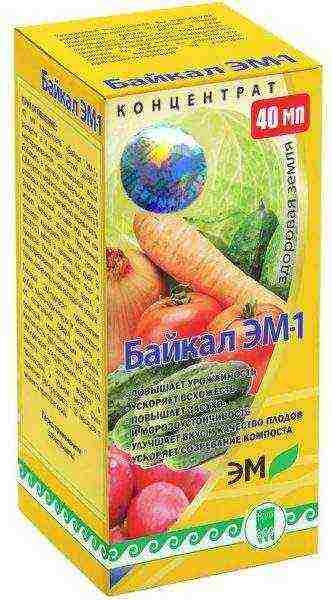
Baikal EM1 contains beneficial bacteria that help the plant to absorb nutrients from the soil
Sowing seeds for seedlings
Strawberry seeds are tugov-like. On the bags, manufacturers indicate the germination period from 1 week to 2 months. This process can be accelerated by preliminary soaking or seed stratification.
Germinating strawberry seeds
Seeds collected or purchased in a store are soaked in rain or melted snow water for 3 days. You will have to change the water 2 times a day. During this time, the seeds will swell. They are laid out in plates on damp paper napkins, wrapped in a plastic bag and placed in a warm place, making sure that the napkins do not dry out. The hatched seeds can be planted in individual peat tablets or in rows in boxes.
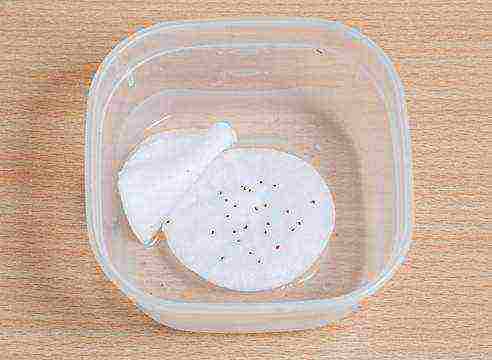
When germinating, the seeds must be constantly in a humid environment.
Seed stratification
Stratification - long-term exposure of plant seeds at a certain temperature to accelerate their germination. Strawberry seeds can be stratified both soaked and already planted in boxes.
Stratification of soaked seeds
Wet seeds are poured into small saucers and covered with foil, then they are placed in a cool place with a temperature of 2-40C, ideally on a refrigerator shelf. Seeds should be checked once a week: ventilated and water added if necessary. Seeds in this state can be stratified from 3 weeks to 3 months.

For stratification, seeds are placed on the bottom shelf of the refrigerator.
Planted seed stratification
The planted seeds are moistened and, covered with a film, are also put into the refrigerator. The box can be kept at 2–40C for about a month and then moved to a warm place. Usually, after this, seedlings appear together.
Seed bubbling
Another way to increase seed germination is bubbling.This is a process in which the seeds are placed in warm water and air. The simplest scheme is to lower the tube from the aquarium compressor into a liter jar with warm melt (rain) water. Seeds must be placed in a gauze bag or poured directly into a jar (if one variety), turn on the compressor for 2 days. It is important that the water temperature is around 25 ° C. After bubbling, the seeds are slightly dried and sown as usual.
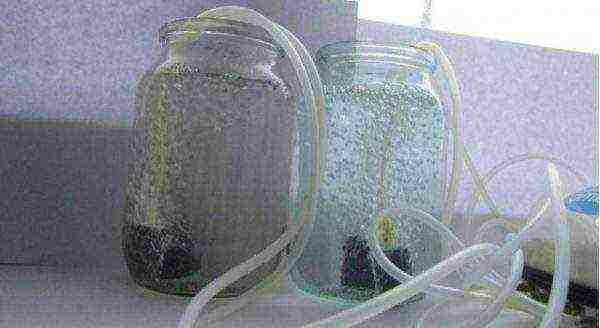
Tough-like strawberry seeds are barbated for 2 days
Sowing seeds in boxes
You can sow strawberries both in boxes and in peat tablets.
- The boxes are taken low, filled with prepared soil, compacted.

Plastic cake container with transparent lid - ideal for growing strawberries
- Shallow grooves are made with a ruler and seeds are sown in them with a toothpick.
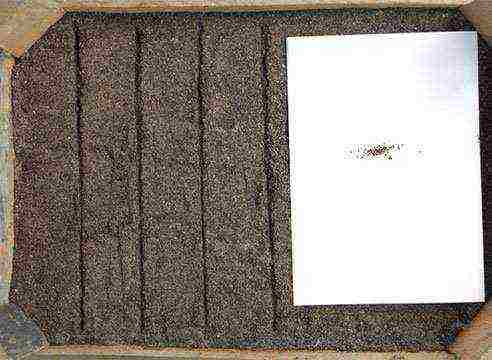
Pour strawberry seeds into small depressions
- Then, without covering the seeds with soil, they are sprayed from a spray bottle and the box is covered with a film.
- If the seeds have not previously been stratified, then put the box in the refrigerator for 2-3 weeks. If the seeds have already been cold treated, then the box is removed to a warm place.
Sowing seeds in the snow
Sowing seeds in the snow is one of the easiest ways to get seedlings.
- Snow is poured into boxes filled with earth, about 1 cm thick.
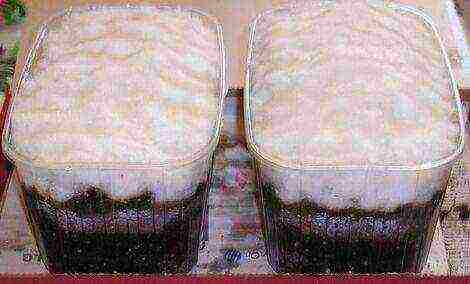
The boxes with soil are filled with fresh snow
- Seeds are poured over the surface of the snow, which are clearly visible on a white background.

Seeds are scattered over the snow
- Cover the planting with a film and put it in a warm place.
When the snow melts, the seeds are slightly pulled into the soil, you no longer need to sprinkle them.
When to sow strawberries
Seed strawberries require warmth and sun. In addition, it grows for a long time - it needs about 5 months before the development of peduncles, so it should be sown in February. Good seedlings of strawberries will grow only when the air temperature is more than 230C and the length of daylight hours is 12-14 hours. Therefore, in February, she definitely needs phytolamp illumination. If there are no such conditions, then plant strawberries in March - April.
Care after landing
The boxes with the planted strawberries must be kept in a warm place, the seeds can germinate both in the light and in the dark. Check and ventilate greenhouses at least once a day by removing condensation drops from the film. Depending on the freshness of the seeds, the producer and the pre-treatment, seedlings can appear in a week or a month.
Seedling care
After the appearance of the first shoots, the boxes must be transferred to the brightest place, under phytolamps or to the south window. It is better not to remove the film for now - too dry air of the apartment will destroy young tender sprouts in a few hours. Therefore, it is better to take trays with transparent lids. You need to water from a syringe or spray with a spray bottle, because young seedlings only slightly cling to the soil with roots.
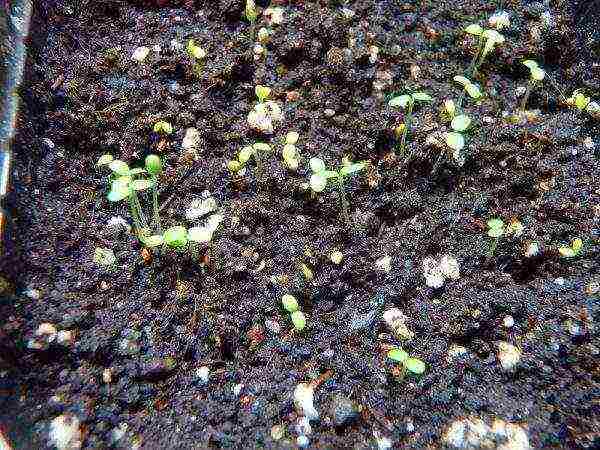
Strawberry shoots are very tender, it is better to leave shelter for the first time
Seedling picking
It is advisable to pick seedlings after 2-3 true leaves appear. A week before, the seedlings need to be accustomed to room air, for this they begin to open the greenhouse lid for a few minutes or leave a slightly noticeable crack. Every day the latch is increased and then the lid is removed completely. Be sure to watch the soil: if it dries up, the plants will die.
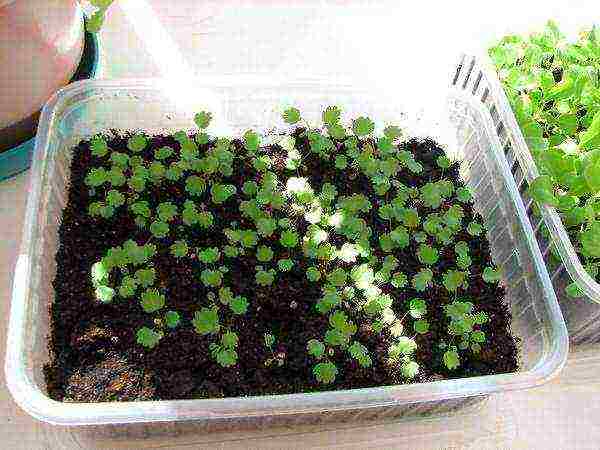
Seedlings ready for picking should have 2-3 true leaves
Individual pots with a volume of 200-250 ml are suitable for cut seedlings, the soil can be taken universal, but add 0.5 liters of vermicompost per 10 liters of substrate.
- Before picking, the boxes with seedlings are well watered.
- Each seedling is pulled out with a stick or small fork.

Seedlings are pulled out of the ground very carefully.
- Long roots are pinched so that the plant forms a powerful root system. Plants are held by the leaves.
- In a pot of soil, make a small depression where the strawberry roots are placed, making sure that they do not bend up.

Strawberries are placed in the ground, holding the plants by the leaves
- The growing point (core) of the plant must be above the ground.
- Planted plants are watered with 1 tbsp. l. water and put in a bright place with shade from the sun.
The first time after picking, you need to carefully look at the seedlings. If the room is dry and hot, it is necessary to spray the leaves with warm water.
To relieve stress in plants, you can add HB 101 to the water (1 drop per 0.5 l).
Top dressing of seedlings
2 weeks after the pick, you can start feeding strawberry seedlings. At this time, the seedlings should actively grow, so it is better to use fertilizers with a predominance of nitrogen. You can use both liquid and water-soluble dry mineral fertilizers. Frequency of use - 1 time in 7-10 days.
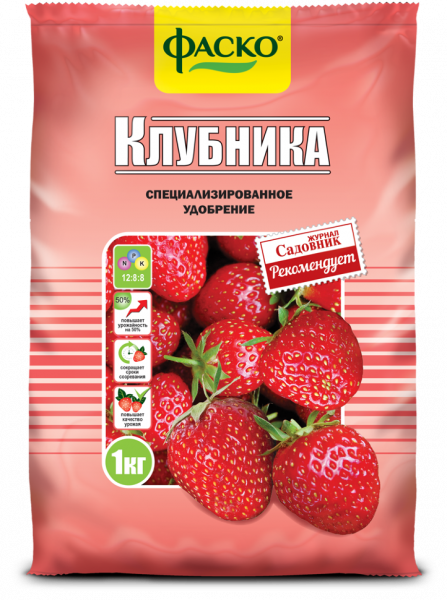
Fasco - fertilizer for young plants, nitrogen predominates in the composition
Strawberry seedling care
The main care for strawberries before planting in the ground or pots is watering, dressing, spraying.
- You need to water the strawberries so that the earthen lump does not dry out, but it is not waterlogged either. You need to focus on the condition of the soil. For example, seedlings standing on a south window in direct sunlight will dry out much more often than seedlings standing under lamps in the back of the room.
- Periodically, plants need to be sprayed with water to maintain optimal humidity, because in dry and hot air, strawberries can be attacked by pests: spider mites, thrips.
- It is not advisable to loosen the seedlings, since the root system of the strawberry is superficial and can be damaged.
- The length of the day for best growth should be about 12-14 hours.
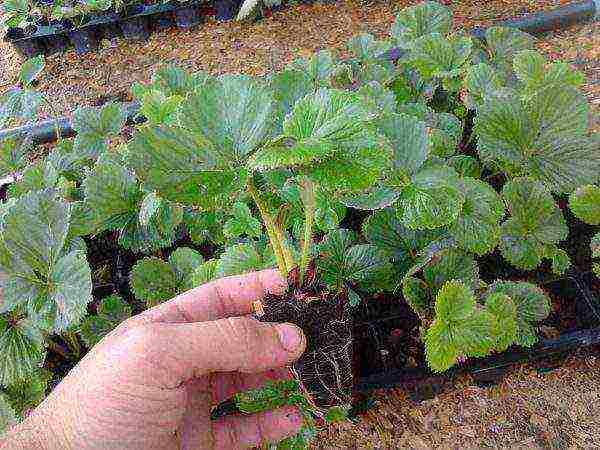
Good strawberry seedlings have strong leaves and well-developed roots
Planting seedlings in open ground
3-4 months after germination, the seedlings can be planted in open ground or in a permanent place in a flower pot - for indoor growing. Plants are planted in open ground from mid-May, or after the temperature is about 20 ° C during the day and 15 ° C at night. Before planting, the seedlings need to be hardened, for this, within a week they are taken out into the open air for several hours (first for 0.5 hours in the afternoon, then for 1-1.5 hours, then left for a longer period).
If it is not possible to harden, then strawberry seedlings can be put in a greenhouse or greenhouse. It is very important to harden plants that have grown without access to sunlight. After planting unprepared seedlings in the garden, the delicate leaves can burn under the bright sun.
Transplant process:
- Seedlings are well watered before planting in the ground.
- On the prepared bed, holes are made at a distance of 30 to 50 cm between the plants (depending on the variety).
- The seedlings are removed from the pot. If the roots are twisted into a spiral, then they need to be straightened, and too long - cut.
- The lump is placed in the hole so that the plant is at the same ground level as in the pot.
- The ground around the strawberries is crushed and watered.
Garden strawberries are called straw berries for a reason. To prevent rapid evaporation of moisture from the soil, the bushes are mulched with chopped straw. It also helps keep crops from rotting.
Video: planting strawberry seedlings in the ground
Alternative ways of planting strawberry seeds
In addition to planting in pots, strawberry seeds can be grown in peat tablets and in a snail.
Video: planting strawberries in a snail
Video: planting strawberries in peat tablets
What varieties are better for growing from seeds
Before the season starts, ask yourself a question: where and why you will plant strawberries.
- container growing at home or on the balcony: you will need remontant varieties and hybrids with different sizes of berries;
- open field cultivation: varieties or hybrids of common large-fruited strawberries;
- growing in a greenhouse for sale: varieties of large-fruited high-yielding remontant strawberries.
In addition, there are varieties that give little or no whiskers. Some varieties bear fruit not only on the mother plant, but also on rosettes formed on the mustache.
Alpine varieties and hybrids of strawberries
Alpine varieties are distinguished by small berries, mainly with the aroma of wild strawberries. Most often - mustacheless, but varieties have appeared that give a small amount of mustache. Alpine strawberries bloom and bear fruit all season, they are more adapted to shady places and are successfully grown on loggias, balconies, apartments, as well as on alpine slides in the open field.
Table: popular varieties of alpine strawberries
Photo gallery: alpine strawberry varieties
Ampelous strawberry varieties
Ampel strawberry is distinguished by the presence of a mustache. In addition, each tendril is immediately ready to bear fruit. If you plant such strawberries in a tall hanging planter, then the hanging mustache, with berries and flowers, creates the impression of a curly one. Such varieties are very demanding on nutrition, especially in the limited space of the pot - they need fertile soil and constant feeding.
Many varieties of ampelous strawberries have pink petals, which is very unusual and beautiful.
Table: varieties of ampelous remontant strawberries
Large strawberry
Garden strawberry (strawberry) is also excellently grown from seed. Many varieties are brought from abroad, but it is important to take into account their winter hardiness.
Table: varieties of large-fruited strawberries for growing from seeds
Photo gallery: varieties of large-fruited strawberries grown from seeds
Reviews of gardeners growing strawberries from seeds
Some strawberry varieties have to be grown exclusively by seed. These are mainly alpine remontant varieties that do not produce whiskers. Also, the cultivation of crops from seeds is often resorted to in the event that it is impossible to buy planting material in the form of outlets.
Hello, my name is Irina, I am 33 years old. I love my collection of hippeastrum very much, but I do not offend other flowers either.
